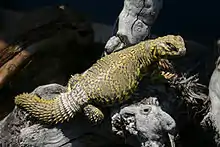Uromastyx geyri
Uromastyx geyri is a species of lizard belonging to the family Agamidae. The species is native to North Africa.
| Uromastyx geyri | |
|---|---|
 | |
| Uromastyx geyri, Saharan Uromastyx | |
| Scientific classification | |
| Domain: | Eukaryota |
| Kingdom: | Animalia |
| Phylum: | Chordata |
| Class: | Reptilia |
| Order: | Squamata |
| Suborder: | Iguania |
| Family: | Agamidae |
| Genus: | Uromastyx |
| Species: | U. geyri |
| Binomial name | |
| Uromastyx geyri (L. Müller, 1922) | |
| Synonyms[3] | |
Common names
Common names for U. geyri include Geyr's dabb lizard, Geyr's spiny-tailed lizard,[3] the Sahara mastigure,[3][4] the Saharan spiny-tailed lizard, the Saharan yellow uromastyx, and the yellow Niger uromastyx.
Habitat
The preferred natural habitat of U. geyri is rocky desert, at altitudes of 500–2,000 m (1,600–6,600 ft).[1]
Etymology
The generic name, Uromastyx, is derived from the Ancient Greek words ourá (οὐρά) meaning "tail" and mastiga (μαστίγα) meaning "whip" or "scourge", after the thick-spiked tail characteristic of all Uromastyx species.
The specific name, geyri, is in honor of German zoologist Hans Geyr von Schweppenburg.[4]
Description
U. geyri is a relatively small, slender species for the genus, with an average total length (including tail) of around 34 cm (13 in). This lizard is usually beige or orange with lighter spots. It is one of the brightest-colored species of the genus Uromastyx. There are two phases of U. geyri, the "red" geyri and "yellow" geyri, color being their only difference. The red phase is often nearly solid reddish to neon pumpkin orange, and the yellow phase is in or near a neon-range. Females are a more pale color than the males, showing more tan variations of the coloring and much less belly coloring as well as less vivid patterns, most females having a simple "freckling" on the back. "Saharans" are medium-sized lizards, many averaging 11–14 in (28–36 cm) in total length, and weighing 250 grams (8.8 oz) or more as adults.
Behavior
U. geyri is terrestrial and diurnal.[1]
Diet
U. geyri is predominately herbivorous.[1]
Gallery
 Stratford-upon-Avon Butterfly Centre, UK
Stratford-upon-Avon Butterfly Centre, UK_a.jpg.webp) Blumengärten Hirschstetten, Vienna, Austria
Blumengärten Hirschstetten, Vienna, Austria
References
- Wilms T, Wagner P, Niagate B (2018). "Uromastyx geyri ". The IUCN Red List of Threatened Species 2018: e.T198536A2531409. https://www.iucnredlist.org/species/198536/2531409. Downloaded on 20 December 2020.
- "Appendices | CITES". cites.org. Retrieved 2022-01-14.
- Species Uromastyx geyri at The Reptile Database www.reptile-database.org.
- Beolens, Bo; Watkins, Michael; Grayson, Michael (2011). The Eponym Dictionary of Reptiles. Baltimore: Johns Hopkins University Press. xiii + 296 pp. ISBN 978-1-4214-0135-5. (Uromastyx geyri, p. 100).
Further reading
- Mertens R (1962). "Bemerkungen über Uromastyx acanthinurus als Rassenkreis ". Senckenbergiana Biologica 43: 425–432. (Uromastyx acanthinurus geyri, new combination and new taxonomic status). (in German).
- Müller L (1922). "Über eine neue Uromastix-Art aus der Zentral-Sahara [= About a new Uromastix species from the Central Sahara]". Naturwissenschaftlicher Beobachter, Frankfurt 63: 193-201. ("Uromastix [sic] geyri ", new species). (in German).
- Wilms T, Böhme W (2001). "Revision der Uromastyx acanthinura – Artengruppe, mit Beschreibung einer nueuen Art aus der Zentralsahara (Reptilia: Sauria: Agamidae)". Zoologische Abhandlungen aus dem Staatlichen Museum für Tierkunde in Dresden 51 (8): 73–104. (in German).
